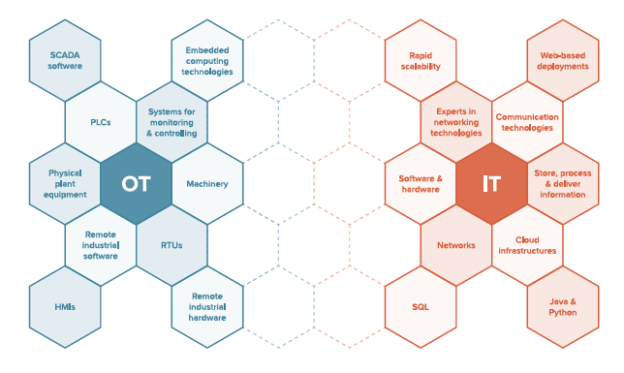
Why OT and IT are Worlds Apart
Organizations and enterprises have discovered that having access to high-quality data helps improve overall business performance. The increasing emphasis on data has shed light on a longstanding divide between the worlds of operational technology (OT) and information technology (IT).
Information technology professionals and enterprise-level departments have leveraged cutting -edge technologies to use data and analytics in making important decisions. While data flows freely within the realm of IT and enterprise-level departments, industrial organizations have, for the most part, kept data and control on restrictive and costly systems, found on the plant or manufacturing floor. OT professionals and industrial organizations continue to struggle for the ability to access industrial data and share it with the rest of the organization. This disparity has prevented those who work at the enterprise level from accessing a wealth of useful data that could aid in their decision-making.
Now, the worlds of OT and IT are at a crossroads: they can work together to realize an amazing opportunity to make industrial data more accessible at every level — or they can continue on separate paths that will keep the organization from reaching its greatest potential. Before we can align these two worlds, however, we should understand why they were divided to begin with.
For a long time, the two areas were kept separate and they innovated by using technologies that addressed problems in their respective areas. These differing problems, approaches, and solutions have contributed to the growing chasm between the two technological giants.
Different Problems
The divide between OT and IT starts with the problems that each area faces. OT professionals are focused on keeping manufacturing, plant, and remote physical equipment in operation for extended periods of time, while IT professionals are focused on keeping data flowing and accessible to all facets of an organization. Because OT and IT have distinctively different requirements, their solutions also differ. OT solutions tend to be restrictive and proprietary, whereas IT solutions tend to be more open and cutting-edge.
Different Technologies
Since OT and IT requirements are different, the technologies that each side uses are different as well. Operational technology encompasses machinery, physical plant equipment, and remote industrial software and hardware. Professionals in OT focus on systems used for monitoring and control. They are adept with programmable logic controllers (PLCs), remote terminal units (RTUs), human-machine interfaces (HMIs), supervisory control and data acquisition (SCADA) systems, and embedded computing technologies.
Informational technology is known for the software, hardware, networks, communication technologies, and systems that store, process, and deliver information to all aspects of an organization. IT professionals are experts in networking technologies and are very familiar with rapid scalability, cloud infrastructures, web-based deployments, databases, Structured Query Language (SQL), Java, and Python.
Different Approaches
Also, OT and IT tend to take different approaches to problem solving. In IT, solutions are implemented using a top-down approach, starting with the big picture, such as an organization’s overall needs. They break the big picture down into sub-components and develop solutions for each sub-component. In the top-down approach, it is important to look beyond the problem itself and to understand the method of the solution as well.
Professionals in OT approach solutions from the ground up, starting from the individual components to build a more complex system. SCADA environments collect data from different processes on the plant floor, so those who work in OT must figure out how to integrate all the systems to work together. Because most OT technologies are proprietary, many SCADA solutions can be difficult to integrate. OT professionals work with sensitive, mission-critical, high- risk systems; therefore, their foremost concern is security, which is why they have avoided Internet and Wide Area Network (WAN) connectivity.
With the introduction of smart machines, Big Data, and the Industrial Internet of Things (IIoT), both OT and IT have found that they need to solve the same problem: accessing industrial data. However, since OT and IT have existed on separate planes, neither side truly understands the other’s needs from a solutions stand point. IT professionals may not understand the reasons why OT still uses legacy equipment and deals with proprietary, astronomically priced solutions. OT professionals may not have in-depth knowledge of SQL databases or the breadth of security protocols used in IT today.
The divide presents a great opportunity for OT and IT to come together and leverage each other’s strengths to deliver a truly disruptive technology. To keep OT and IT separate is an outdated, pre-IIoT mindset that will not allow industrial organizations to be competitive going forward. To meet the demands of today’s data-intensive environment, enterprises must work to align OT and IT. In the next article in the series, we will examine some of the organization-changing benefits that can result from a proper alignment of OT and IT departments.